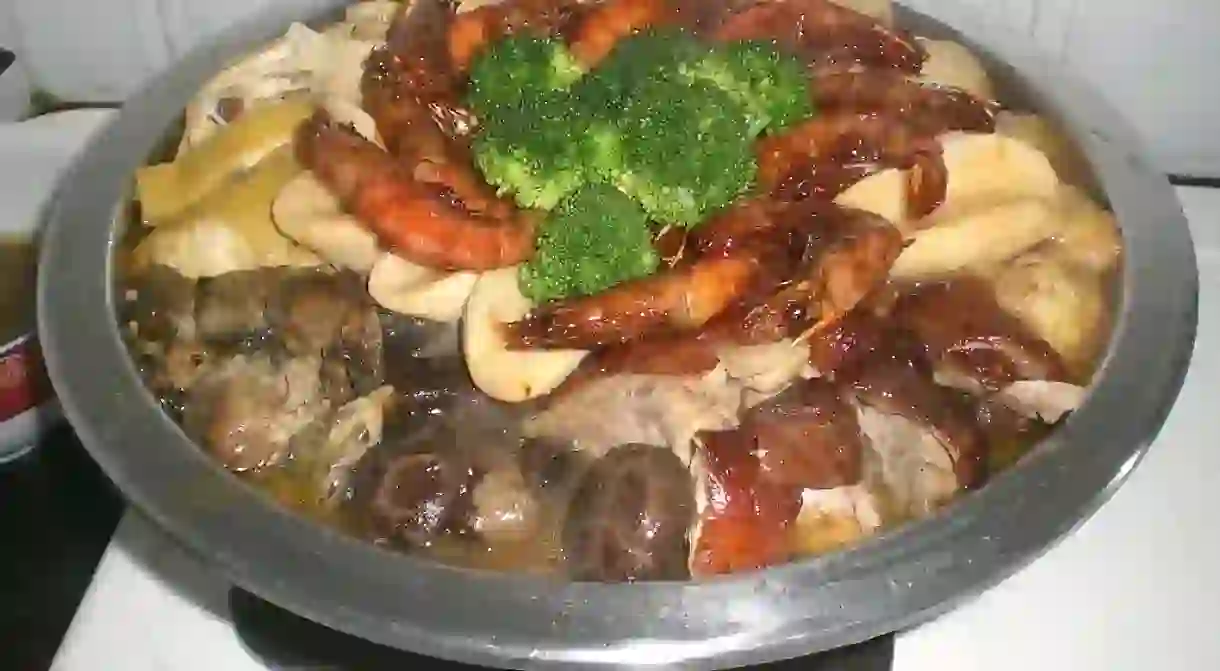The History Of Poon Choi, Hong Kong In 1 Minute

Poon Choi , which is literally translated to “Chinese casserole in a basin”, composes an important part of the Walled village culture in the New Territories. Villagers feast on the cuisine whenever there are celebrations connected with rituals, weddings, festivals, ancestor worship and other local events as an expression of village dining culture. However, this traditional Chinese dish was first invented in the Song Dynasty. It contains critical cultural values to Hong Kong and has shifted into different shapes in our modern world.
Poon Choi has existed in Hong Kong for more than 7 centuries. It is said that it was originated in the late Song Dynasty. When Song China was intruded by Mongolia, the young Emperor Bing (960-1279 AD) fled to the area around Guangdong Province and Hong Kong. To feed the emperor and his army, the locals collected quality and seasonal produce food and cooked it. Due to the lack of serving containers, ingredients were conscientiously crammed inside a wooden or clay washbasins.
Poon Choi is Hong Kong’s walled village (also known as Wai Tsuen) homegrown. This folk dish is associated with the New Territories early inhabitants, who have been driven to Hong Kong due to frequent barbarian invasions in China between 13th and 17th century. Continuous threat from invaders and pirates nearby during these bumpy times leaded to the build up of villages encompassed by thick safeguarding walls, the remains today of which can still be seen in coastal New Territories.

Since large portion sizes is the trademark of Poon Choi , it is often served as a mainstream dish during celebrations including rituals, weddings, festivals, ancestor worship and other local events as an expression of village dining culture. Though the tradition is descended by older families in the New Territories, the dish is seldom well-received with newbies to Hong Kong, mostly because it is rarely served in a restaurant except during festivals.
Poon Choi, which is literally translated to “basin food”, is just what its name suggests- a large basin filled up with up to 14 ingredients (such as pork, beef, lamb, chicken, duck, abalone, shark fin, fish maw, prawn, crab, dried mushroom, fish balls, squid, dried eel, dried shrimp, pigskin, bean-curd, daikon , bamboo shoots), assembled into a casserole. Each item is prepared separately and then layered meticulously in the basin. The final product has a stew-like consistency, with the juices of the meat fusing with other ingredients. The most prized items such as roast duck, prawns, dried mushrooms are placed on top, low-profile ingredients such as turnip and taro, are placed at the bottom to absorb the glorious gravy from the meat on top. Villagers don’t usually include a lot of vegetables in Poon Choi as they are not seen as valuable ingredients and it is a way to show respect to their guests.The contents are warmed to no more than 30 minutes over an open-fire just before serving.

The cuisine has critical cultural values in the walled villages. Villagers use only the best and freshest ingredients in Poon Choi is a way to pay respect to their ancestors. This behavior illustrates the character of traditional Chinese people, who remain grateful to ancestors. It also reflects their image of being very hospitable. Poon Choi also symbolizes teamwork and unity. Cooking Poon Choi requires a lot of manpower among villagers which unites them together. This gourmet has reflected different family lineages. The Poon Choi recipes of every village are not disclosed to people who do not belong to the village. The recipe is seen as an inheritance passed from villager to villager and father to son over generations. Enjoying Poon Choi demonstrates equality because the rich and the poor can eat it together. The cuisine also signifies affluence and prosperity in the coming year.

Poon Choi is no longer confined to walled villages nowadays. Thanks to the promotion by mass media in which Poon Choi events are largely publicized, such as the Poon Choi Banquet held by Rural Functional Constituency and the large-scale Poon Choi Banquet held in 1997. Economic depression is another reason for its popularity in urban areas. Since Poon Choi is a one-basin dish composing a lot of ingredients, HongKongers think it is more affordable than other restaurant meals. In the old days, citizens had to come across so much trouble to visit the walled villages in order to have a bite of Poon Choi. However, with the rise Poon Choi specialized stores such as Hung Wan Dishes, 8Mei Company and ubiquitous Chinese fast food restaurants such as Café de Coral, Fairwood which offer Poon Choi, the gourmet can be enjoyed anytime anywhere.

Poon Choi has also reflected Hong Kong’s creativity in food culture. A lot of modern twists have been made on this traditional cuisine to cater to people’s constantly changing taste bud. Some posh versions offer delicacies such as oysters, abalone, dried scallops and shark fin. There are some that provide pumpkin and carrots which make incision easier for the elderly and vegetarian meat for non-meat eaters. Since Hong Kong is an international city, a variety of Poon Choi flavors like Japanese Poon Choi, curry Poon Choi as well as Western Poon Choi are also available.














